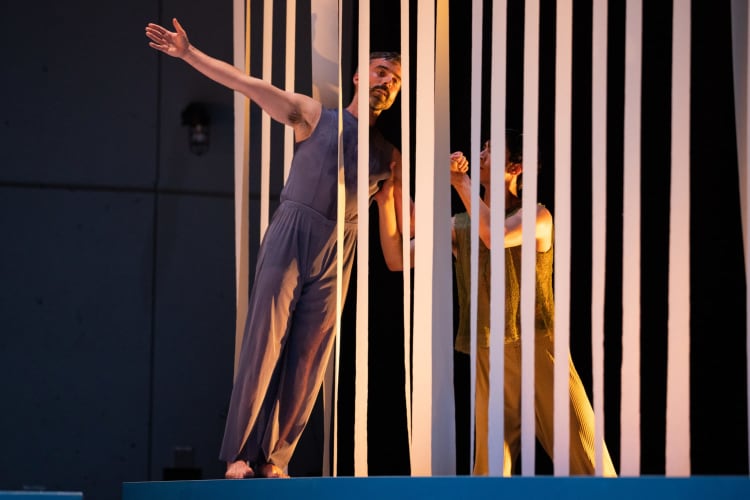Pam Tanowitz, choreographer and creator of Song of Songs, has taken on the task of transforming biblical erotic poetry into an engaging contemporary movement experience. It’s an ambitious and startlingly beautiful result, but not easy to connect such erotically charged lyrics to the outpouring of abstract movement.
For Tanowitz, making Song of Songs began in 2019 when the choreographer wanted to create a dance that would honour the memory of her father and her own Jewish roots. Inspired by a rare love poem in the Tanach—the Hebrew Bible—the dance is constructed from fragments of dance history woven into a new form.
It speaks Merce Cunningham inspired positioning of the body with fierce straight arm and leg lines and diagonals that are then spliced and cut into by collapsing bodies. Frantic movements from flitting, flicking feet and arms accentuate the sharp geometrical patterns in a contradictory tug of war.
Tanowitz then pulls on Jewish folk dance by introducing circle dance moments as a backbone for much of the movement, deconstructed and layered in classical and contemporary form. Dancers link arms, stamp feet, step forward and back suggesting the Hora—a celebratory dance bringing community together at Jewish weddings.
The choreography is highly original at all times as it swerves between classical shapes, contemporary quirkiness and folk dance. Arms thump on chests as if dancers are warriors in a call to arms more than romantic gesticulations and as the erotic poetry peals out across the auditorium, "let him kiss me with the kisses of his mouth," finding the right dance expression to match the rich language is tough.
While movement is keenly observed and deeply mapped out, it can't quite carry the weight of words and the dance rarely feels sweepingly emotional, even with the herculean energy and commitment from both dancers and musicians powering the performance. But perhaps this was the intention.
Instead, Song of Songs is a masterclass in pure abstraction. There are no lover sighs or erotic embraces. Rather, as dancers flit around the stage, often in separate capsules catapulting out of from between the fabric sets, it couldn’t feel further away from a community infused folk dances. While the steps are recognisable, the meaning is lost or changed in this setting.
The sets are strikingly functional. Designed by Tanowitz herself, Harriet Jung, Clifton Taylor and Reid Bartelme, they reflect and frame the dance with long vertical geometric lines of cloth resembling window blinds used to slice up bodies that move in between the material, appearing and disappearing.
Then there are odd blue disc platforms that the dancers use as a prop jump on and off, elevating shapes and forms. Turns out the design team studied images of the Abuhav Synagogue in Israel, which houses a bright blue bimah (a platform in all synagogues from which the Torah is read). Onstage, the idea is that it lends a sacred space for the dancers.
At the heart of Song of Songs is composer David Lang's elegiac score, commissioned specifically for the piece. The musicians stand at the back of the stage, but are very much part of the overall theatrical flow of performance triggering the impetus for movement throughout. There are three singers, cello, viola and percussion. Soprano Sarah Braily is mesmerising as her honeyed tones resonate across the stage, releasing sweet poetic biblical nothings into thin-air such as, "just your cheek, just your neck."
The live repetitive music becomes a meditative chant, but the words that spill out are the only graspable link between movement and content. While the text is densely rich and poetic, the movement in response is often pared down and sparse. Thus one rarely feels like an expression of the other.
Yet Song of Songs is a work of rare and poised elegance. While it may not take on any literal resemblance of biblical poetry, it inhabits the same space and infuses movement with an air of mystery and complexity. It may be hard to fathom at times, but this is pure abstraction with the rulebook torn up and stitched back together Tanowitz style—elusive, brilliant and beautifully executed.
